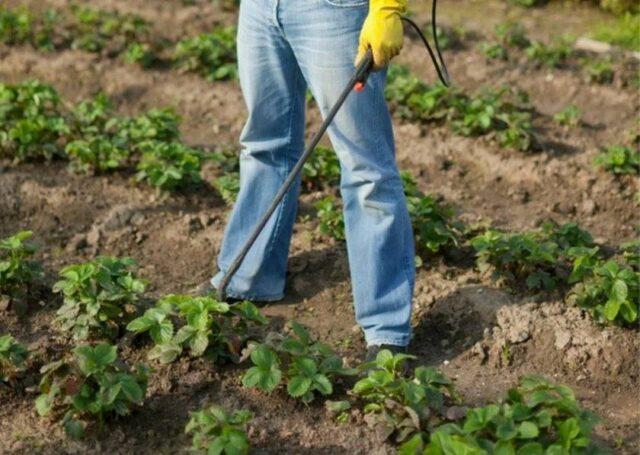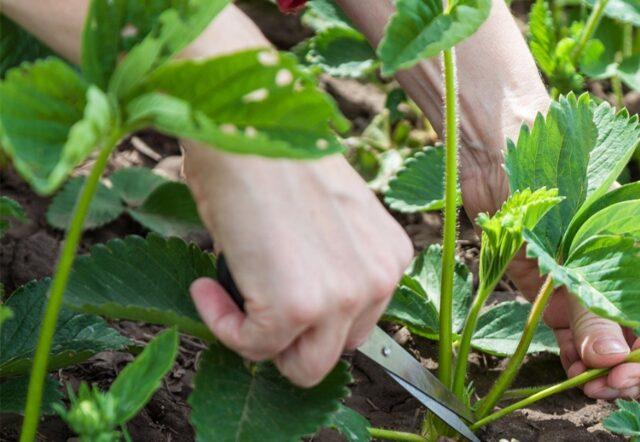Content
Strawberries are a rather “capricious” plant, susceptible to fungal diseases and pest attacks. Without regular preventive measures, it is impossible to collect good harvests of berries. Copper-containing preparations are harmful to pathogenic fungi. You can use both modern fungicides and products that have long been well known to gardeners. Treating strawberries with copper sulfate has proven its effectiveness.
Is it possible to spray strawberries with copper sulfate?
Copper sulfate (also known as copper sulfate or copper sulfate) is one of the antibacterial agents well known to gardeners for a long time, suitable for the vast majority of ornamental and fruit-bearing crops in household plots. Strawberries are no exception; they are also sprayed or watered with a chemical solution to protect them from pathogenic microflora or get rid of pathogenic fungi if infection cannot be avoided.

Copper sulfate is a universal antiseptic for the garden, suitable for treating strawberries
The chemical can be used in the following cases:
- to “burn out” the pathogen;
- as part of a set of spring activities or as part of preparing bushes for winter;
- during the season, if weather conditions favor the activation of pathogenic microflora;

After the expiration date, it is not recommended to use the chemical; the benefits of spraying are noticeably reduced
Features of the use of copper sulfate
The “saturation” of the solution varies depending on the purpose of its use:
- 0.2-0.3% - feeding for copper deficiency;
- 1% - prevention of infection by pathogenic microflora, destruction of fungal spores overwintering in the soil;
- 1-3% - treatment of bushes already affected by pathogenic fungi; the concentration varies depending on the severity of the symptoms and the severity of the problem;
- 3-5% - disinfection of the soil in the garden bed after removing infected plants from it.
When processing, it is necessary to take into account the composition of the soil. If the soil in the beds is peaty or sandy, annual procedures are required. Loam, chernozem, and other fertile substrates are initially characterized by a higher content of copper, which is destructive for pathogens, so one treatment every 3-4 years is often sufficient here.
The chemical belongs to hazard class III. Accordingly, its use requires compliance with basic precautions:
- Work with the chemical using personal protective equipment. You also need closed, waterproof shoes, clothing made of thick fabric with long sleeves and trousers.
- While working with the substance, you should not eat, drink, or smoke.
- Any solution that gets on the skin should be immediately washed off with soap suds, in the eyes or mouth, or on other mucous membranes with cool, clean water. In case of accidental ingestion of liquid, gastric lavage is required. If the substance enters the digestive tract in its pure form, it can lead to serious chemical burns and severe poisoning.
- The containers in which the solution was prepared become unsuitable for storing food and drinking water.

Despite the moderate danger of copper sulfate, precautions when working with it cannot be ignored
When to treat strawberries with copper sulfate
You can treat strawberries with copper sulfate from early spring to late autumn. The exception is the period of flowering and fruiting. Any spraying negatively affects the process of ovary formation, since the chemicals are dangerous for bees and other pollinators. The berries become unsuitable for food for the next 1.5-2 weeks after the procedure.

Copper sulfate is a highly toxic chemical for bees and many other insects.
How to dilute copper sulfate for spraying strawberries
Most often, 1% copper sulfate is diluted to process strawberries in spring and autumn. To prepare the solution you will need 100 g of granules and 10 liters of water. The algorithm is very simple:
- Pour the entire powder with about a liter of hot water, but not boiling water (70-75 ° C).
- Stir vigorously until the granules are completely dissolved.
- Add the remaining water, also heated to 40-50 °C.
- Allow the solution to cool to room temperature, strain if necessary.

Copper sulfate crystals dissolve in hot water in 2-3 minutes
During the preparation process, avoid contact of copper sulfate with any metal. Use plastic, ceramic or glass containers, fabric or nylon filters. This requirement also applies to a sprayer or watering can.
How to properly treat strawberries with copper sulfate
The most effective use of the chemical will be if you take into account several important nuances:
- The most suitable temperature is 3-5 °C. At 30 °C or more, the chemical is practically useless. When the temperature drops below 0 °C, the procedure completely loses its meaning. In summer, it is recommended to postpone spraying until the beginning or end of daylight hours.
- For the procedure, choose a cloudy, windless day. In hot weather, the liquid quickly evaporates from the plants and from the soil; burns may remain on the strawberry leaves. A strong wind “blows away” drops of copper sulfate solution, significantly reducing the effectiveness of the procedure.
- It is necessary to strictly observe the dosage and frequency of treatments. If you increase the concentration of copper sulfate in the solution and reduce the intervals between spraying, you can cause serious harm to the strawberries, including the death of the plants.
- Even a light rain, not to mention a heavy downpour, washes most of the solution off the leaves. After this, re-processing is necessary. Therefore, it is recommended to take into account the weather forecast and spray strawberries at least three hours before precipitation.
- At the early stage of damage by pathogenic microflora, one thorough treatment is usually enough. The solution is sprayed not only on the front side of the leaves, but also on the stems, trying to ensure that the liquid gets into the center of the rosette. In “severe cases”, 2-3 treatments are carried out with an interval of at least seven days.
- The procedure includes watering the soil in the garden bed with a solution of copper sulfate. To avoid burning the roots of the plants, the soil is well moistened with plain water about an hour before the procedure. Before processing, it is recommended to loosen the substrate.

The protective effect after treating strawberries with copper sulfate lasts for about 30 days
How to treat strawberries with copper sulfate in the spring
The main purpose of treating strawberries with copper sulfate in the spring is to prevent infection by pathogenic fungi. Before the leaf buds bloom, it is sprayed with a 1% solution, spending approximately 1 l/m².
Also in the spring, gardeners practice treating purchased strawberry seedlings with copper sulfate before planting them in the garden. 2-3 hours before transferring it to open ground, its roots are soaked for 15-20 minutes in a solution of the same concentration. Specimens with a closed root system are watered with it 4-5 days after planting, having previously moistened the soil with ordinary water.

In spring, copper sulfate is used to treat both strawberries in the beds and new seedlings
How to treat strawberries with copper sulfate in the fall
Autumn treatment of strawberries with copper sulfate is part of a set of measures to combat pathogenic microflora and properly prepare for winter. First you need to trim the bushes, weed the bed, remove all plant and other debris from it, and loosen it well.
The consumption rate and concentration of the solution for treating strawberries with copper sulfate in the fall is the same as in the spring, if the bushes grow and develop normally. When symptoms of copper deficiency were noted in the summer, it is advisable to fertilize 10-15 days after the procedure with complex organomineral fertilizer, adding copper sulfate to it (concentration - 0.3-0.5%).
If in the fall you get rid of strawberries that are severely affected by a fungal disease, especially powdery mildew, late blight, verticillium, or any types of spotting, cleaning the bed for other crops, the soil must be disinfected. The soil is spilled with a 3-5% solution of copper sulfate. 2.5-3 liters of liquid are consumed per 1 m² of beds.

Without removing debris from the garden, processing strawberries will not give the desired effect.
How to store the solution
Most gardeners prefer to use a “fresh” solution of copper sulfate. But the liquid does not have to be used immediately; it can be stored without loss of “consumer properties” for up to a year.
To do this, prepare a concentrated 10% solution and pour it into a glass or enamel container with a tight-fitting lid. If there is no such container, a plastic container will do.
The copper sulfate solution is kept in a dark room with a constant temperature of about 20 °C. The container must be placed separately from food, animal feed, medicines, and drinking water containers.

Before use, the “concentrate” is filtered and the required volume of water is added.
Conclusion
Treating strawberries with copper sulfate is an effective means of protecting plants from pathogenic fungi and treating specimens already affected by pathogens. This is one of the most common and affordable fungicides, the effectiveness of which has been tested and proven by more than one generation of gardeners. However, in order for treatment with copper sulfate to benefit strawberries, it is necessary to choose the right time for the procedure and prepare a solution of the required concentration.








